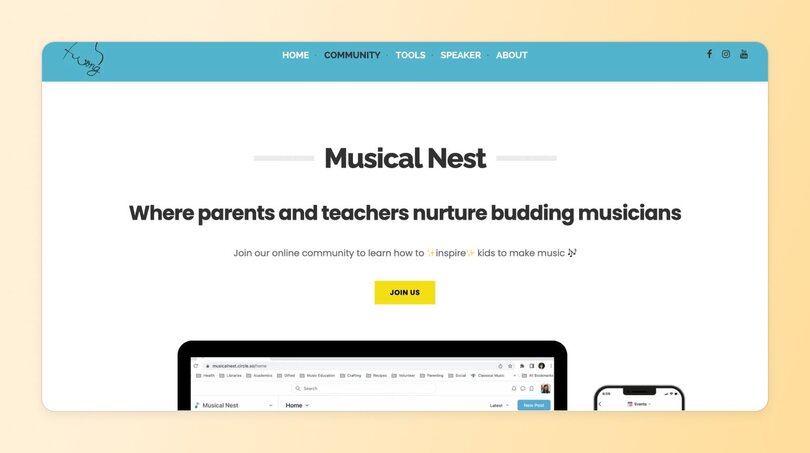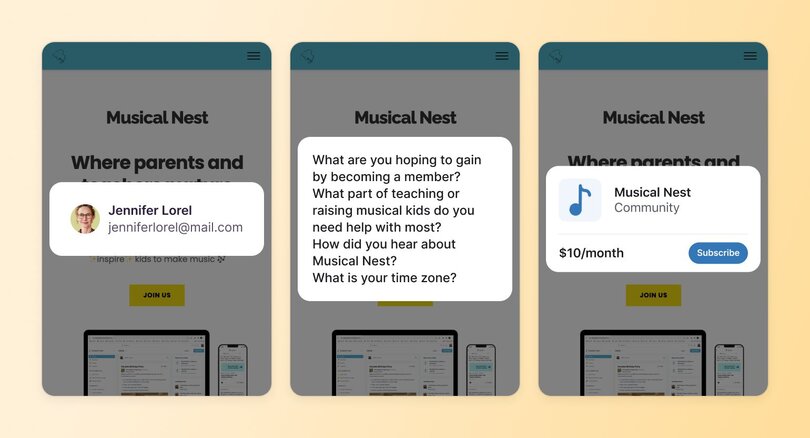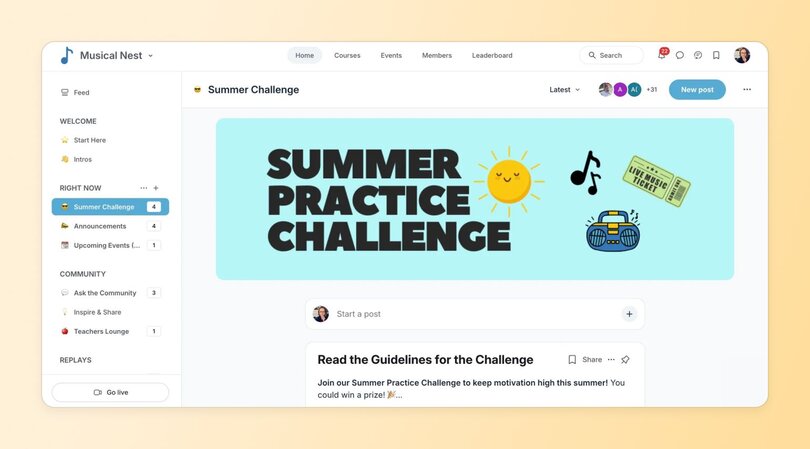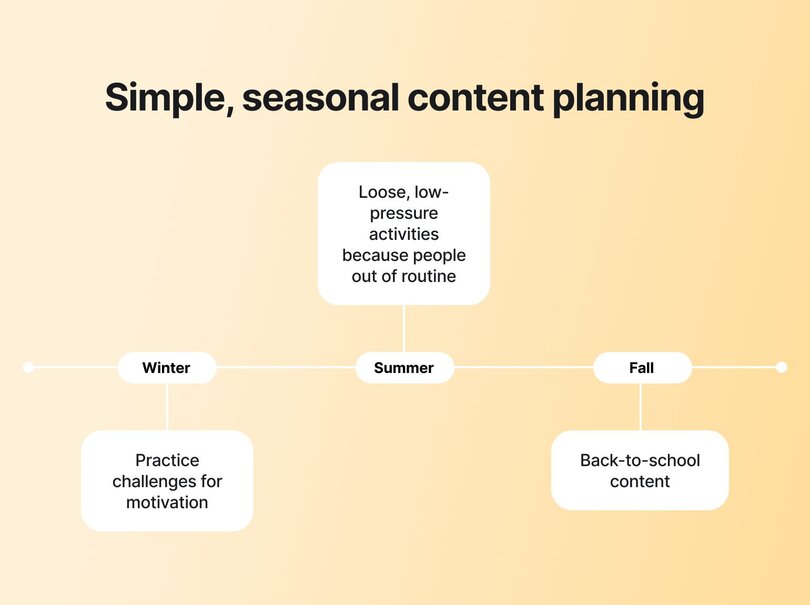Musical Nest’s low-pressure engagement model for busy members
Is there a way to get kids to practice without the power struggle? What if it could be... fun?
Music educators and parents Barbie Wong and Christine Goodner think so. And they built Musical Nest to prove it.
Launched in October 2024, Musical Nest is a Circle community designed to make music education easier and more joyful for families. It connects parents and teachers through expert-led resources, seasonal programming, and creative online community challenges that keep kids motivated.
This article explores how Barbie and Christine structured their community to support low-effort, high-impact engagement. It also looks at why they’re taking a slow, intentional approach to growth and what other community builders can learn from their collaborative leadership.
If you’re:
- Dreaming up your own niche community?
- Or trying to survive practice time with your mini Mozart?
Musical Nest offers a model worth tuning into.
Meet Musical Nest
Both longtime music educators and parents themselves, Barbie and Christine had been tackling the same tough questions from different angles:
- How do we help kids want to practice?
- And how do we support the adults guiding them?
Christine, a violin teacher, once struggled through practice sessions with her kids. So much so, she created a podcast about how to practice with your child with less conflict and how to support that practice relationship.
Barbie, a piano and ukulele teacher, had a similar experience.
“When my kids were young, I was trying to figure out how to get them excited about practice,” she shared. “I realized that if I can't figure it out and I have two degrees in music, then what's everybody else doing?”
When Barbie discovered Christine’s work, she felt seen.
For Christine, her motivation was simple: “Be who you needed when you were younger.”
“What I needed when I was a younger teacher or a newer parent was some place to go with the things that weren't going well,” she explains. “To get support somewhere that didn't feel embarrassing to say, ‘I don't know what to do,’ or ‘This feels hard.’”
Their aligned vision and goals led to them co-founding an online community: Musical Nest.
Part music teacher community, part parent support group, and part practice pep squad, Musical Nest helps grown-ups navigate the messy, meaningful work of raising young musicians.

The community breakdown:
📍 Community: Musical Nest
👋 Founders: Barbie Wong and Christine Goodner
🗓️ Launched on Circle: October 2024
🌟 Size: 77 active members
🎯 Purpose: Bring together parents and music teachers to help children build joyful, consistent music habits
💰 Pricing model: Paid membership ranging from $120-$144/year
From solo struggle to co-led success
So how do you build a learning community that feels more collaborative than overwhelming?
For Barbie, the answer didn’t come right away. “I tried to launch it before and it didn’t work,” she admits. “At some point, I realized this is just too hard to do by myself.”
Barbie met Christine around the time she started building the community on Circle. At first, Christine was busy running her music studio, but eventually, she carved out space in her schedule and agreed to come on board.
That decision changed everything.
“With Christine… suddenly this whole thing became… I would say like 95% fun versus before it was about 50/50,” says Barbie.
Since then, the two have developed a strong, collaborative working rhythm—dividing tasks based on their strengths and checking in regularly to stay aligned.
Partnership operations:
- Task division: Barbie handles tech and posting; Christine leads content creation and outlines
- Meeting frequency: Monthly planning sessions, plus weekly check-ins
- Collaboration style: Christine drafts outlines → Barbie implements in Circle
- Decision making: Both review timing and content together before anything goes live
“I love that Barbie takes my ideas and makes them show up magically, from my perspective, in Circle,” Christine adds.
A community designed for busy grown-ups
Musical Nest isn’t for kids. It’s for the grown-ups supporting them.
And those grown-ups? They’re juggling a lot: teaching, parenting, managing busy schedules. That’s why everything from the landing page to onboarding is simple, welcoming, and easy to navigate.
Their pre-community lead capture strategy reflects this:
- Two-step process: Page one captures contact info with a Tally form. Page two gathers more detail and directs to the Circle paywall
- Follow-up friendly: They can reach out to people who don’t convert
- Insight-driven: Helps identify common barriers like not realizing the community is paid
Their paid membership is straightforward—$10/month annually or $12/month quarterly—with a 14-day money-back guarantee.

Once inside, the focus shifts to helping members stay connected without feeling overwhelmed. Barbie and Christine know their audience doesn’t always have time to log in regularly so they’ve built a light, low-pressure communication system that keeps people in the loop.
Member communication strategy:
- Dual approach: Community posts + email reminders
- Monthly emails: Keep Musical Nest top-of-mind for members who turn off notifications
- Templates provided: Easy, copy-paste invites for members to share with friends
- Personal touch: Barbie sends direct messages to new members and follows up by email if there's no response
From there, members can explore expert tip videos, join themed discussions and community calls, or quietly engage on their own schedule.
“We just keep it as simple as we can so that they can hop right in,” Barbie adds.
Online community challenges that actually work
What motivates kids to practice music? And how can parents and teachers work together to make it feel fun and not forced?
Musical Nest might have cracked the code with their online community challenges. Their January 30-Day Practice Challenge was a standout example, combining structure, flexibility, and just the right amount of incentive.
Challenge mechanics:
- Registration: Google Form for sign-ups
- Challenge-specific pricing: $10 for 30-day challenge vs. $36 for 3-month membership
- Tracking: Manual tracking viable for small communities (under 50 people)
- Participation criteria: Even a simple thumbs up or like counted toward completion
- Prize tiers:
- 15–19 days: Stickers
- 20–29 days: Stickers + luggage tag
- 30 days: Custom tote bag + other items
- Sourcing: Amazon for music-themed items (easy and affordable)
- International consideration: Prizes were chosen to be easily mailable overseas
- Random drawing: 3 total prize winners to keep costs manageable
The challenge was a hit and a reminder that challenges for community engagement don’t have to be complicated to be effective. Barbie and Christine are currently running a bingo-style version for the summer.

Programming with purpose
Planning content for two busy audiences isn’t easy. So how do you build a music teacher community online that supports both parents and teachers? And what should a community for music educators include to keep members engaged without burning them out?
Barbie and Christine start by planning everything around the natural rhythm of the school year.

Seasonal content strategy:
- Winter: Practice challenges to tap into New Year motivation
- Summer: Loose, low-pressure activities like practice bingo, since many families are out of routine
- Fall: Back-to-school content focused on finding music teachers and preparing for lessons
- Community meetings: Monthly events with real-world themes (e.g., May = recital season)
The two cofounders meet monthly to map things out. They also release one short video each week, with topics like how to gamify and incorporate play into practice.
“Because Barbie and I both work with parents and teachers all the time, we tend to take a topic and then look at it from different angles,” Christine explains.
Their community library also includes quick courses like Barbie’s Motivate Kids to Practice class for time-strapped parents.
What they’ve learned about slow growth
From the beginning, Barbie and Christine have taken a steady, intentional approach to building Musical Nest, focusing more on member experience than rapid expansion.
“We both really like how slow we’re growing,” Barbie says. “We know this might not sound like what most people want, but I like that we’re slowly, steadily growing.”
That mindset has allowed them to create a space where members engage in ways that fit their lives. Some show up to every live event. Others watch videos quietly in the background. Some offer feedback behind the scenes.
They use member surveys to understand what people value and how they prefer to participate.
“We're realizing some people are passive engagers,” Barbie says. “They just like the content and they’ll do it on their own time.”
They’ve also added features like Parent Talks—interviews with parents of musicians—and a private Teachers’ Lounge for more sensitive conversations. Practice challenges remain the most active part of the community. But every interaction helps them shape what’s next.
Right now, they’re exploring studio memberships, which would let teachers invite entire groups of parents to join Musical Nest. They’ve also planned a summer retreat day to set their vision for the rest of the year.
“I like that we’re building something really slow and really strong,” Barbie says. “So that when we get to 100 members, or 200, everything will be steady and we’re going to have a high-quality product.”
Advice for other community builders
Building a community doesn't have to be overwhelming—for you or your members.
"We both really like how slow we're growing," Barbie says. "I like that we're building something really slow and really strong."
Their approach? One video per week, one community call per month. That's it.
Barbie compares being part of Circle to taking a course: "Go to Office Hours when you can. Ask questions when you have them. It's also the other people who will jump in and give their two cents."
Christine's biggest lesson? "Keep an open mind about what your community actually needs." She originally imagined Musical Nest as a text-based hangout space. It evolved into something quieter—a better match for busy parents and teachers.
"Know what your vision is, but what that looks like in practicality could be different. And that's okay."
Not everyone will show up to live events, and that's fine. "We're realizing some people are passive engagers," Barbie explains. "They just like the content and they'll do it on their own time."
Building something meaningful takes time, but it doesn't require constant hustle.